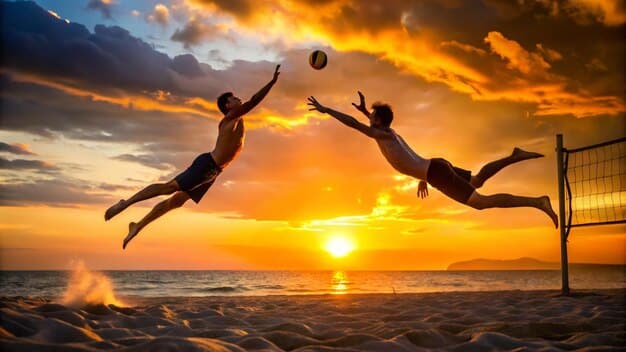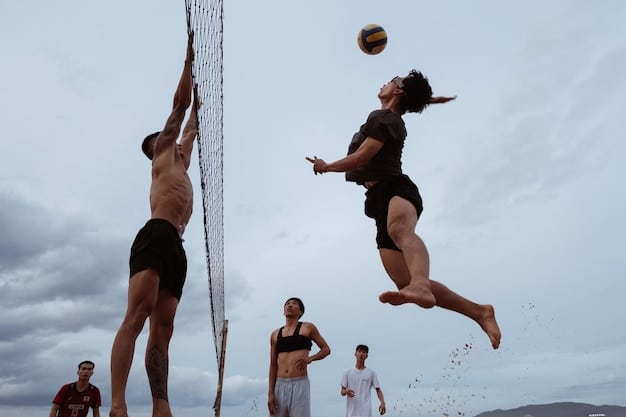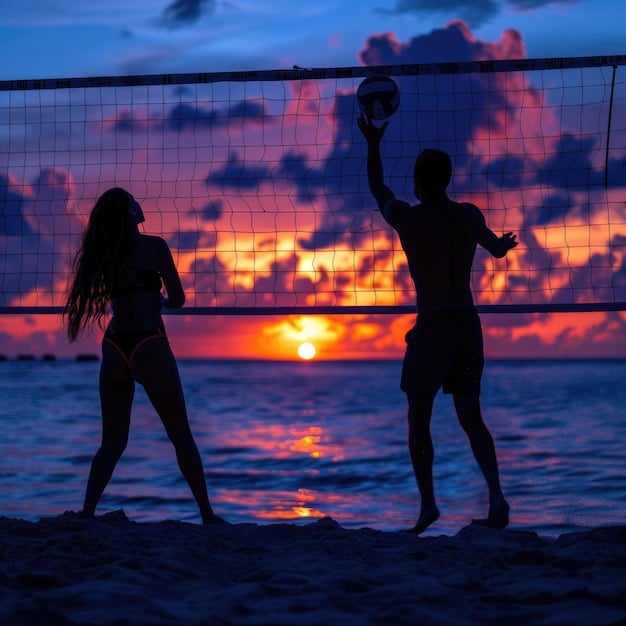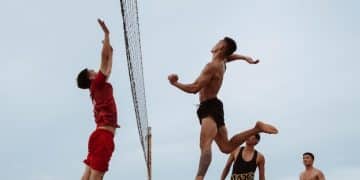Beach Volleyball Strategies: Boost Your Win Rate by 15%

Mastering beach volleyball requires adaptable strategies, effective communication, and precise execution of defensive and offensive tactics to achieve a significant win rate improvement.
In the dynamic world of beach volleyball, where two-player teams navigate unpredictable elements, a slight strategic edge can translate into a significant lead. This article explores key Beach Volleyball Strategies: Improve Your Team’s Win Rate by 15% with These Tactical Adjustments, offering insights grounded in experience and designed to refine your approach, enhance teamwork, and ultimately secure more victories on the sand.
Understanding the Game: Beyond Basic Skills
Beach volleyball stands apart from its indoor cousin, demanding not just athletic prowess but also acute tactical intelligence. The smaller court, fewer players, and ever-present elements like wind and sun create a unique strategic landscape. Success on the sand isn’t merely about hitting hard or jumping high; it’s about anticipating, adapting, and executing a well-thought-out plan.
A fundamental understanding of the game’s core mechanics is crucial. Unlike indoor volleyball, where substitutions are common and specific positions are held, beach volleyball requires both players to be versatile, covering all aspects of offense and defense. This duality demands constant communication and a fluid understanding of each other’s strengths and weaknesses.
The Importance of Communication
Effective communication is the bedrock of any successful beach volleyball team. Because there are only two players, every decision, from who takes the ball to where to place the shot, must be conveyed instantly and clearly. Miscommunication often leads to easy points for the opponent.
- Verbal Cues: Use short, clear phrases like “mine,” “yours,” “line,” or “cut” to indicate intentions.
- Non-Verbal Cues: Hand signals for blocking or attacking strategies save time and prevent opponents from anticipating your moves.
- Post-Play Debrief: Briefly discussing why a point was lost or won helps in rapid learning and adjustment.
Beyond the simple calls, communication also involves reading your partner’s body language and understanding their tendencies under pressure. Building this intuitive connection takes time and practice, but it drastically reduces errors and enhances fluid play.
Many teams struggle because they fail to establish a robust communication system. Implementing simple rituals, like a pre-serve huddle to confirm strategy, can transform a team’s coherence and effectiveness.
Ultimately, a team that communicates seamlessly is a team that operates as a single, cohesive unit, capable of making split-second decisions that alter the outcome of a rally. This initial strategic layer underpins all other tactical adjustments you might consider.
Mastering Defensive Strategies
Defense in beach volleyball is not merely about reacting; it’s about anticipating and positioning. A strong defensive game can disrupt opponents’ rhythm and create opportunities for counter-attacks. Improving your team’s win rate by 15% often starts with shoring up your defense.
The primary defensive strategies revolve around effective blocking and digging (receiving attacks). Both require an understanding of opponent tendencies and tactical positioning. The goal is to either prevent the attack from reaching the court or to control its trajectory for an easy counter-attack.
Effective Blocking Techniques
Blocking is the first line of defense, aiming to shut down the opponent’s attack at the net. A successful block requires timing, positioning, and a keen understanding of the hitter’s approach.
- Line Block: The blocker positions themselves to cover the opponent’s strongest hitting angle (usually down the line).
- Angle Block (Cut Shot Block): The blocker adjusts to cover the sharp cross-court shot, forcing the hitter to go line or high over the block.
- Reading the Hitter: Pay attention to the hitter’s approach, arm swing, and body orientation to anticipate their shot direction.
The role of the blocker also influences the defender’s position. If the blocker takes the line, the defender covers the angle, and vice-versa. This coordinated effort ensures that both primary attack zones are protected. A common mistake is for blockers to jump haphazardly without a clear intention, which often leaves large gaps for the opponent.
Practicing specific blocking scenarios can significantly improve your team’s reaction time and coverage. Drill exercises that simulate various hitting angles will make your blocking intuitive rather than reactive.
Moreover, the block isn’t always about outright preventing the ball from crossing the net; sometimes, a “soft block” meant to absorb power or redirect the ball can set up an easier control for the defender.
Strategic Digging and Court Coverage
When the block is bypassed, the burden falls on the defender. Strategic digging involves more than just getting the ball up; it’s about putting it in a playable position for your partner. Optimal court coverage depends on the blocker’s choice and the opponent’s attacking tendencies.
The defender must be agile, quick, and possess excellent court awareness. Reading the opponent’s attack early allows for better positioning. For example, if the blocker commits to the line, the defender shifts aggressively to cover the sharp cut shot, being ready to quickly transition to a scramble play if the ball is tipped.
Developing a system for defensive coverage, where each player knows their responsibility based on the opponent’s setup and the blocker’s action, is paramount. This removes uncertainty and allows for more aggressive reads and quicker reactions, which are essential for digging tough shots.

Refining Offensive Plays
While defense wins games, offense scores points. A varied and unpredictable offense keeps opponents off balance and creates weaknesses to exploit. To legitimately improve your win rate by 15%, your offensive repertoire needs to be diverse and intelligently applied.
Offensive plays in beach volleyball go beyond just hitting hard; they include strategic shot selection, intelligent setting, and exploiting opponent weaknesses. The goal is to make it difficult for the defense to anticipate your move.
Shot Selection and Placement
One of the hallmarks of an experienced beach volleyball player is their ability to choose the right shot at the right time. This often involves more finesse than power.
- Cut Shot: A sharp cross-court shot designed to land quickly inside the court.
- Line Shot: A powerful shot hit parallel to the sideline, aiming for the deep corner.
- Pokeys and Pushes: Soft touches over the block or to open areas, used when opponents are out of position.
- High Line/Rainbow: A lob shot over the block, aimed deep down the line, often effective against aggressive blockers.
Understanding when to use each shot comes from reading the defense. If the blocker commits heavily to one side, an open lane often appears elsewhere. If the defender is playing deep, a short shot can be devastating. Varying your shots prevents opponents from anticipating your next move.
This element of surprise is a critical component of offensive success. Over-reliance on one type of shot, even if powerful, makes a team predictable and easier to defend.
Strategic Setting
The setter’s role is crucial in offense, essentially dictating the quality of the attack. A good set allows the hitter to execute their preferred shot with maximum efficiency.
- Targeted Sets: Placing the ball precisely where the hitter can easily attack it, considering their hitting preference and the wind direction.
- Varying Set Location: Sometimes setting tighter to the net, other times a bit further off, to keep blockers guessing.
- Calling the Play: The setter often signals the desired attack (e.g., a high set for a power hit, a quick set for a tip).
The best setters anticipate their hitter’s needs and the opponent’s defensive setup. They adjust the set accordingly, whether it’s a tight set for a quick tip or a high, floaty set that allows the hitter to get on top of the ball. Communication between setter and hitter is vital to ensure the set is delivered as expected.
Practicing different types of sets under various conditions, especially with wind, will hone this skill. The quality of the set directly impacts the probability of a successful attack. A perfectly placed set simplifies the hitter’s job and maximizes the chance for a point.
Ultimately, a well-executed offensive strategy involves a seamless transition from serve receive to set to attack, with each element designed to probe and exploit defensive weaknesses. This collaborative effort transforms potential opportunities into concrete points.
Leveraging Environment and Opponent Weaknesses
Beach volleyball isn’t just about athletic skill; it’s also about environmental awareness and psychological warfare. Adapting to the elements and exploiting opponent weaknesses are critical strategic adjustments that can noticeably improve your team’s win rate.
The wind, sun, and even the texture of the sand can play significant roles in a match. Ignoring these factors is akin to playing with a handicap. Meanwhile, every opponent has a flaw; identifying and targeting it is a cornerstone of advanced strategy.
Playing with the Wind and Sun
The elements are constants in beach volleyball and can be turned into an advantage.
- Wind:
- With the Wind: Serves can be hit with more power and dive more sharply. Attacks can be hit flatter.
- Against the Wind: Serves need more arc to carry over the net. Attacks might require more loft to prevent them from hitting the net early. Tipping becomes more effective as the ball is slowed.
- Sun:
- Serving into the Sun: Aim serves high to force opponents to look directly into the sun when receiving.
- Attacking into the Sun: Use tips or high shots that are hard to track against the sun’s glare.
Experienced teams meticulously analyze the wind patterns and sun position before and during a match. They adjust their serving, passing, setting, and attacking techniques to minimize the negative impact of the elements and maximize their beneficial effects.
For example, a serve hit high into a strong wind can become erratic and difficult to pass. Similarly, a well-placed tip into the sun can blind a defender at a crucial moment. These subtle adjustments add layers of complexity and effectiveness to your game plan.
Recognizing and utilizing these variables allows a team to play smarter, not just harder, often leading to a distinct advantage over less adaptable opponents.
Identifying and Exploiting Opponent Weaknesses
Every team, no matter how skilled, has vulnerabilities. Identifying these and structuring your game plan around them is a hallmark of strategic beach volleyball.
Observe:
- Passing: Who is the weaker passer on the opposing team? Serve to them consistently.
- Hitting Range: Does one player struggle with line shots or cross-court attacks? Force them into their weaker hitting zones.
- Blocking/Defense: Is one player less mobile, or does their block leave a specific angle open? Target that area.
- Communication Issues: Do opponents show signs of miscommunication under pressure? Increase the tempo and variety of your attacks.
This requires keen observation during warm-ups and early rallies. Once a weakness is identified, the strategy should pivot to exploit it. This might mean consistently serving to one player, always hitting a specific angle, or forcing a less athletic player to make dynamic plays.
Exploiting weaknesses also involves mental pressure. If a player consistently struggles with a certain type of shot, repeatedly hitting that shot can erode their confidence and increase errors. This psychological aspect can be as impactful as physical prowess.
The most successful teams are those that can not only execute their own game plan but also swiftly adapt it to dismantle their opponent’s. This analytical approach to the opposition is a powerful tool for elevating your game.
Team Dynamics and Mental Fortitude
Beyond the technical and tactical aspects, the intangible elements of team dynamics and mental fortitude play an immense role in beach volleyball success. A 15% increase in win rate often stems from a stronger internal team cohesion and resilience under pressure.
The unique nature of beach volleyball, with only two players, amplifies the importance of these factors. Every interaction, every reaction, shapes the team’s overall performance. A strong bond and unwavering focus can turn the tide in critical moments.
Building Chemistry and Trust
A beach volleyball team is a partnership, and like any partnership, it thrives on chemistry and trust. When players trust each other’s abilities and decisions, they play more freely and effectively.
- Shared Goals: Both players must be aligned on their objectives and commitment to improvement.
- Mutual Support: Encouraging each other during difficulties and celebrating successes strengthens the bond.
- Understanding Roles: Clearly defined roles, even if flexible, reduce ambiguity and improve coordination.
Chemistry isn’t just about being friends; it’s about understanding and anticipating your partner’s moves, knowing their tendencies under pressure, and being able to communicate effectively without words. This deep understanding allows for seamless transitions and quick recoveries from errors.
Regular practice, open communication about performance, and even shared experiences outside of volleyball contribute to building this crucial bond. A strong partnership is more resilient in the face of adversity and more capable of exploiting opportunities.
Trust also means knowing your partner will carry their weight and that you can rely on them to execute their part of the strategy. This fundamental belief allows both players to focus fully on their individual tasks without concern for their partner’s performance. When this is in place, the team operates almost effortlessly.
Developing Mental Resilience
Beach volleyball matches can be long and grueling, often with momentum swings. Mental resilience – the ability to stay focused, positive, and strategic irrespective of the score – is paramount.
- Short-Term Memory: Forget past mistakes quickly and focus on the next point.
- Positive Self-Talk: Maintain a constructive internal dialogue, even when frustrated.
- Focus on Process: Instead of outcomes, concentrate on executing the strategy correctly.
- Handling Pressure: Develop routines for high-pressure situations (e.g., serving for match point).
Competitions inevitably present challenges: bad calls, strong opponents, or sudden shifts in conditions. A team with strong mental fortitude does not crumble under such pressure. Instead, they use these moments as opportunities to demonstrate their resolve and strategic adaptability.
Techniques such as visualization, deep breathing, and pre-match routines can help develop mental toughness. Moreover, addressing performance issues with a solutions-oriented mindset, rather than dwelling on blame, fosters a more resilient team environment. This ability to reset and refocus after a lost point or a difficult rally is what prevents a downward spiral and allows for comebacks.
Ultimately, a team that is mentally tough and possesses strong internal chemistry is better equipped to navigate the unpredictable nature of beach volleyball and consistently perform at a higher level, turning close matches into wins.
Training Methodologies for Strategic Improvement
To truly enact the strategic adjustments discussed and see that 15% win rate improvement, specific training methodologies must be incorporated into your practice routine. It’s not enough to know the strategy; you must train to execute it flawlessly under pressure.
Effective training extends beyond simply playing games. It involves targeted drills, scenario-based practice, and analytical review designed to embed strategic thinking into every movement and decision.
Drill-Based Training for Specific Scenarios
Instead of merely scrimmaging, focus on drills that isolate and refine specific strategic elements. This allows for repetition and immediate feedback on execution.
- Serve Receive Drills: Practice various serve types (float, topspin, sky ball) under different wind conditions, aiming for perfect passes to a target zone.
- Attack-Defense Transition Drills: Simulating real-game scenarios where one player attacks, and the other defends, forcing quick transitions between offense and defense.
- Blocking and Digging Coordination: Drills where one player practices blocking a particular shot, and the other positions themselves to dig the resultant attack or tip.
- Decision-Making Drills: Sets where players have to quickly read the block/defense and select the most appropriate shot (e.g., hitting line, angle, or tipping).
These focused drills build muscle memory for strategic execution. They allow players to make mistakes without consequence and learn from them, iteratively improving their ability to implement tactical choices. For example, regularly drilling specific blocking assignments will make those actions automatic in a game.
The key here is repetitive, high-quality practice that simulates game pressure. The more comfortable players are executing specific strategies in practice, the more likely they are to apply them successfully in competition.
Match Analysis and Strategic Review
Learning from past performances is a powerful tool for strategic improvement. This involves objective review, not just emotional reactions to wins or losses.
- Video Analysis: Filming practices and matches allows for objective review of positioning, shot choices, and communication. Seeing yourself play from an external perspective often reveals flaws that are invisible during live play.
- Statistical Tracking: Keep track of serve percentages, attack efficiency, block touches, and digging success rates. Identifying trends can pinpoint areas needing improvement.
- Post-Match Debrief: Both players should discuss what worked, what didn’t, and why, immediately after a game. This should be constructive, focusing on solutions.
A systematic approach to analysis helps in identifying patterns in opponents’ play and equally important, in your own team’s performance. For instance, if statistics show a low success rate on cross-court attacks from a certain position, it indicates a need for drill work on that particular shot.
This analytical layer transforms practice from mere repetition into purposeful development. By understanding the ‘why’ behind successes and failures, teams can formulate more precise training plans and make more informed strategic decisions in future matches.
Ultimately, a holistic training approach combining targeted drill work with rigorous analysis creates a feedback loop that continually refines skills and strategies, making the aspiration of increased win rates a tangible reality.
| Key Strategy | Brief Description |
|---|---|
| 🗣️ Enhanced Communication | Crystal-clear verbal & non-verbal cues for seamless play. |
| 🛡️ Adaptive Defense | Strategic blocking and precise digging based on opponent reads. |
| 🚀 Varied Offense | Smart shot selection and accurate setting to exploit court space. |
| 🧠 Mental Toughness | Building resilience and chemistry to perform under pressure. |

Frequently Asked Questions About Beach Volleyball Strategies
▼
Wind is a significant factor, causing balls to drift. Serving with the wind can add power, while serving against it requires more height. Attackers often use the wind to their advantage for deep shots or adjust for tips. Defenders must anticipate wind-affected trajectories more accurately.
▼
Optimal communication involves concise verbal calls (e.g., “mine,” “line”) and clear non-verbal hand signals for blocking and attacking. Constant dialogue, both pre-point and post-point, about strategy, opponent tendencies, and partner positioning is essential for seamless play and rapid adjustments.
▼
No, not always. While blocking is crucial, sometimes a “pull-off” block (where the blocker drops back to defend) is more strategic, especially against skilled tippers or when the opponent has a significant height advantage. The decision depends on game flow, opponent analysis, and team strategy.
▼
Improving shot selection comes from reading the opponent’s defense and practice. Observe where defenders are positioned and where the block is. Try to identify open court spaces. Practice various shots (line, angle, tips, pokes) so you have a diverse arsenal to choose from, keeping opponents guessing.
▼
Court awareness means understanding your position, your partner’s position, and the opponent’s position in relation to the ball and court boundaries. It involves knowing where the open spaces are, anticipating where the ball will go, and adjusting your movement proactively rather than reactively.
Conclusion
Improving your beach volleyball team’s win rate by 15% is an ambitious yet achievable goal, rooted in a multifaceted approach that combines refined technical skills with astute strategic thinking and unwavering mental fortitude. By prioritizing fluid communication, mastering both defensive and offensive nuances, intelligently leveraging environmental factors, and understanding opponent weaknesses, teams can unlock new levels of performance. Furthermore, adopting specific training methodologies and engaging in thorough match analysis are crucial steps to solidify these improvements. Ultimately, success on the sand is a reflection of constant adaptation, collaborative effort, and a dedicated pursuit of strategic excellence.





